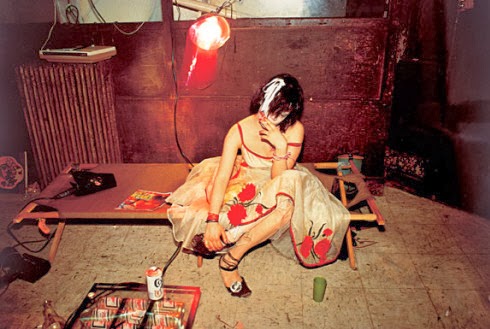 |
| Goldin, Nan, Self-Portrait on the Train #2, 1992. |
A good portrait photographer is able to capture the essence of their subjects within a photograph. Few do this as well as contemporary photographer Nan Goldin. She is known for taking extremely personal photographs of her family, friends and lovers, which is a key fact to note when studying Goldin's work. Her subjects have often been dubbed "The Family of Nan" due to the level of intimacy Goldin is able to capture in her photographs.
Born in Washington D.C. area, Nan Goldin was brought up in a liberal and progressive middle class home. Her father worked in broadcasting and Goldin was the youngest of four children, although she was the closest with her older sister, Barbara Holly. At the age of eleven, Goldin's eighteen year old sister committed suicide, which was an act that had an big effect on Goldin's photographic eye, particularly later on in Goldin's career. Shortly after, Goldin and her family moved to Boston, where she met David Armstrong at the age of fourteen. Armstrong and Goldin became friends and studied photography together.
In 1968, at the age of fifteen, Goldin enrolled at the Satya Community School, where she first started to study photography. In 1973, Goldin had her first solo show in Boston, where she showed black and white silver gelatin prints of the city's gay and transsexual communities:
 |
| Goldin, Nan. (Left) Lola Modelling, Boston, (Middle) Crystal with a Friend, Boston, (Right) Naomi, 1972 - 73. |
Goldin continued her education School of the Museum of Fine Arts/Tuffs University in Boston, where she earned her BFA in 1977 and her Fifth Year Certificate in 1978. After graduation, Goldin moved to New York City and began photographing several "underground" groups such as the Post-Punk New-Wave Music Scene, the Post-Stonewall Gay and the Hard-Drug Subcultures of the late 1970s to mid-1980s. During these years, Goldin also traveled to London, Berlin and Provincetown, Massachusetts to document her "extended family".
 |
| Goldin, Nan, French Chris on the Convertible, NYC, 1979. |
 |
| Goldin, Nan, Trixie on the Cot, NYC, 1979. |
The photographs that Goldin shot during the late '70s through the mid '80s were often showed as a slideshow with music overlay, titled The Ballad of Sexual Dependency. This body of work was first displayed in 1979 in a New York City nightclub. Goldin displayed portraits of individuals out partying; bringing the viewer through a euphoric and dysfunctional settings. Her photographs within the series also show Goldin and her friend's romantic encounters. This body of work was an ever evolving project, to which Goldin continued to add images to through 1986. Goldin published some of the images from her slideshow in a book in 1986. The images published within this book were
simultaneously showed at the Burden Gallery in New York. The following
year, Goldin won the Photographic Book Prize of the Year for the publication. In my opinion, some of the photographs in this series pose a question, "Are humans depended on relationships in order to survive?". The viewer might perceive Goldin as a voyeur although Goldin has always insisted that she is not "crashing the party" with her camera because it is her party and the photographs are taken of her friends:
 |
| Goldin, Nan, The Hug, New York City, 1980. |
 |
| Goldin, Nan, Greer and Robert on the Bed, New York City, 1982. |
 |
| Goldin, Nan, Brian and Nan in Bed, New York City, 1983. |
The photograph above was featured on the cover of The Ballad of Sexual Dependency and portrays an intimate couple, Goldin herself and her then boyfriend, Brian. However, the content behind the image is revealed by their gestures; they are both on opposite ends of the bed. The light within the image further separates them and Goldin's expression almost portrays a sense of fear yet wanting to be closer to her boyfriend. This photograph was taken with a cable release and the content within the image certainly portrays what was to come after in terms of her relationship with Brian.
 |
| Goldin, Nan, Nan One Month After Being Battered, New York City, 1984. |
The photograph above shows the aftermath of Goldin's relationship with Brian. This self-portrait shows the viewer the brutal truth of the effects of domestic abusive. "The injuries she received almost cost her her sight in her left eye" (Armstrong, 46). Goldin saw this portrait as warning to herself to not return to Brian.
Stay tuned for the next post in this special Pho·tog Friday series about Nan Goldin's life and The Ballad of Sexual Dependency!
____________________________________________________________________________
01. Costa, Guido, and Nan Goldin. Nan Goldin. London: Phaidon, 2001. Print.
02. "Nan Goldin." Wikipedia. Wikimedia Foundation, 12 May 2013. Web. 06 Dec. 2013.
03. Garratt, Sheryl. "The Dark Room." The Observer. Guardian News and Media, 06 Jan. 2002. Web. 06 Dec. 2013.
04. Wolf, Kate. "The Ballad Continues: On Nan Goldin." Los Angelos Review of Books. N.p., 23 Dec. 2012. Web. 06 Dec. 2013.







